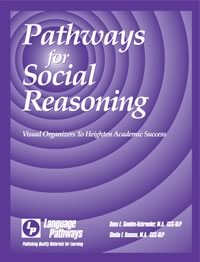Pathways for Social Reasoning & Problem Solving: An excellent resource for everyday social reasoning experiences. Using visual organizers can make problem solving about social experiences more concrete and visually explicit while identifying important language skills and concepts.
This resource provides visual organizers for use with:
- Identifying Feelings and Ranges of Emotion
- Increasing Self Awareness
- Improving Attention, Focus, Topic Maintenance, Frustration Tolerance
- Cause and Effect Reasoning
- Situational Problem Solving
- Only $41.95

Who Does Pathways for Social Reasoning and Problem Solving Benefit?
Pathways for Social Reasoning and Problem Solving is a resource of visual organizers designed to assist professionals working with students experiencing language and communication difficulties often associated with semantic-pragmatic language impairments, High-Functioning Autism, Asperger Syndrome, or Non-Verbal Learning Disabilities. Often these students are described as having social-cognitive deficits. While many of the organizers were initially developed and inspired by students we have worked with who have been diagnosed with high functioning Autism and Asperger Syndrome, we have found them to be quite effective when working with students diagnosed with language impairments and related attentional difficulties. Professionals acknowledge several theories when describing students with social-cognitive deficits based on their communication challenges. Students with these challenges can often display difficulties in one or more of the following areas: receptive/expressive language functioning, central coherence, taking perspective (Theory of Mind) and executive functioning skills of organization and planning. Students who exhibit these difficulties often experience breakdowns in comprehension, expression, and social problem-solving. The visual organizers in this book were developed as tools to assist professionals facilitating improvement in these areas by providing students a visual structure for completing tasks and reasoning about their experiences.
How Visual Organizers for Social Reasoning and Problem Solving Facilitate Student Growth?
Many resources are available that outline therapeutic approaches when working with students with social-cognitive deficits such as those developed by Tony Atwood, Carol Gray, and Michelle Winner. The visual organizers found in this resource were developed solely as tools to complement social cognitive instruction by providing students a visual structure for thinking and reasoning, organizing and planning, and communicating their knowledge and intent. It provides an additional modality of visual support when using therapeutic language strategies such as cognitive mediation and verbal scaffolding, which offers a means of reflection and guides the thinking process. This can encourage students to more actively participate in the problem solving process versus simply responding passively to those attempting to facilitate improved social reasoning. It is in this way that visual organizers provide a scaffold for organizing and eliciting information by showing the connections between concepts involved within the complex language of communication and social reasoning. The visual framework they provide helps students organize their expressive language functioning when reasoning about their experiences and conceptualizing events to a larger whole. This can range from reflecting on multiple perspectives within a social interaction to understanding language concepts within directives that may include terms such as “evaluate”, “analyze”, “organize”, and “reason”.
Because social reasoning often requires comprehension and use of abstract cognitive concepts, it is often necessary to break down these concepts into more concrete, manageable chunks to ensure language understanding. This is a step often necessary before successful application of such knowledge and skills can be expected; therefore, completed organizers have been provided to introduce a variety of social-language concepts. They are not only available for breaking down and recording information but are a tool to facilitate improved comprehension and critical thinking. Identifying and recording steps for problem solving can also be a benefit, giving students a visually explicit tool for self-evaluation. Ultimately once the visual organizers are completed, they can be used for extensive reflection and planning by not only breaking down tasks into manageable chunks, but helping to pull information back together into a meaningful gestalt. The repetitive use of visually similar organizers can also provide a structured model for social reasoning and problem solving across a variety of environments and experiences. This in turn can facilitate greater depth of comprehension and mastery of skills.
While examples have been provided to demonstrate possible application and use of the organizers, professionals are encouraged to individualize according to student need. When students use their own examples, it not only makes the information being learned more meaningful, it increases comprehension and application of learned concepts, an essential component when socially reasoning and problem solving about their experiences. It is also our belief that social reasoning skills cannot be taught effectively without the real life experiences of social interactions to understand events and apply skills learned. Therefore the visual organizers in this resource were not intended to be used in isolation, but as a supplement to reinforce concept knowledge and reduce the information processing demands often experienced by students when “verbally” discussing their experiences, analyzing responses, and targeting behaviors to be changed. Ultimately it is hoped that the use of the visual organizers in this resource will assist students and professionals when developing a structured approach for personal problem solving and enhancing communicative effectiveness.
The content of this book has been organized into four sections:
- Visual Organizers for Concept Development
- Visual Organizers for Social-Emotional Awareness
- Visual Organizers for Perspective and Situational Problem-Solving
- Visual Organizers for Self-Evaluation and Planning
Completed examples found in this book have been generated by students and typed in for easy reading and to demonstrate their use. Blank organizers are also frequently provided for more personalized use. It is intended that this resource will be used as a flexible tool to assist professionals working with students experiencing difficulties with social reasoning, problem solving, and executive function difficulties affecting organization and planning within the academic setting. It is important to note that organizers should be modified to meet each individual child’s need and learning style.
